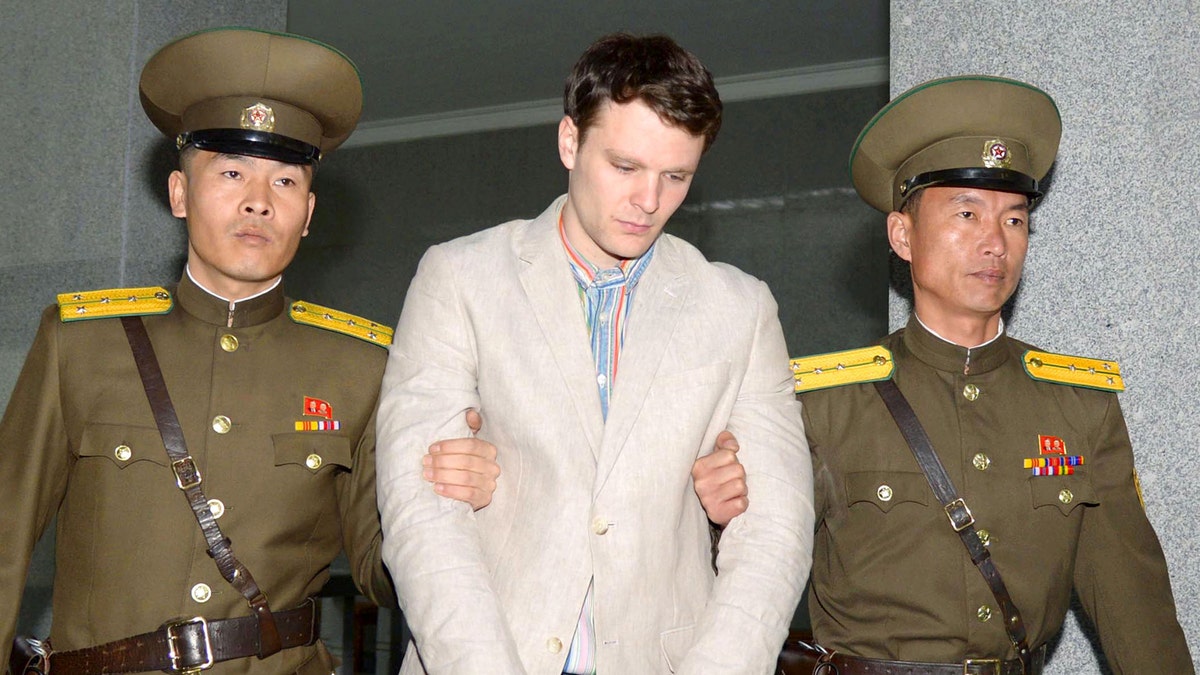
Otto Frederick Warmbier (C), a University of Virginia student who was detained in North Korea, is taken to North Korea's top court in Pyongyang, North Korea, in this photo released by Kyodo March 16, 2016. (REUTERS/Kyodo)
The case of American student Otto Warmbier, who sustained serious injuries while he was detained in North Korea, is renewing the focus on the horrors that prisoners face in North Korea’s infamous torture camps.
Officials at the University of Cincinnati Medical Center, where Warmbier is being treated, said that while there is no physical evidence he was beaten, his “extensive loss of brain tissue” suggests he likely lost blood supply to his brain for a period of time.
How that happened is up for debate, but after a seemingly healthy 22-year-old college student winds up with severe brain damage shortly after being sentenced to 15 years of labor, some experts are inclined to remind people about the kinds of brutality that regularly occur in North Korea’s infamous camps.

Otto Warmbier, a 22-year-old college student detained and imprisoned in North Korea, is carried off of an airplane at Lunken Airport in Cincinnati on Tuesday, June 13, 2017. (Sam Greene/The Cincinnati Enquirer via AP)
Graphic video footage of what are reportedly interrogations at North Korean camps reveal that prisoners are bound at the hands as they are subjected to whatever cruelties the guards feel like inflicting. And, according to some former guards who have since defected, the level of cruelty is entirely up to them.
In a 2014 documentary on life inside of North Korea's labor camps, "Camp 14: Total Control Zone," one former labor camp official suggested that the guards at these camps serve as judge, jury and executioner.
Kwon Hyuk, who is identified in the film as an ex-commander of the guards in a North Korean labor camp, said prisoners are "treated like animals" once they arrive at the camps.
OTTO WARMBIER HAS EXTENSIVE BRAIN DAMAGE, DOCTOR SAYS
"The life of an inmate is worth less than the life of a worm,” he said. “They can't defend themselves, not even when they're being beaten. I could do anything with the prisoners that I like. The decision whether to kill them or let them live was completely up to me."
In a 2014 Sky News report, "The Defectors," escapees from North Korea's prison camps suggest that they are unable to fall asleep at night because "from every room there are sounds, sounds of beatings."
North Korean officials have denied that there are any "labor camps" in the country at all, instead suggesting that they are places designed for "education." According to the United Nation Human Rights Commission, "the very existence of political prison camps is considered a state secret, even though international human rights groups have reported about them since the late 1980s."

American student Otto Warmbier speaks as Warmbier is presented to reporters Monday, Feb. 29, 2016, in Pyongyang, North Korea. North Korea announced late last month that it had arrested the 21-year-old University of Virginia undergraduate student. (AP Photo/Kim Kwang Hyon)
And in a 2014 report, the U.N. commission documented in specific and graphic detail the kinds of cruelty that goes on at some of these camps.
“The unspeakable atrocities that are being committed against inmates of the kwanliso political prison camps resemble the horrors of camps that totalitarian states established during the 20th century,” the report states.
Researchers concluded that, at the time, there were anywhere from 80,000 to 120,000 political prisoners actively detained in what were described as "four large political prison camps, where deliberate starvation has been used as a means of control and punishment."
AMB. BOLTON: NORTH KOREA'S TREATMENT OF OTTO WARMBIER WAS 'BARBARIC'
Witnesses interviewed for the U.N. report describe how “special torture chamber[s]” exist in these prison camps for the sole purpose of unconventional cruelty. There are hooks from which people can hang upside-down, needles for driving under fingernails, and special chili-pepper concoctions for pouring down a victim’s nose.
Multiple subjects also describe how subjects are immersed in water tanks to the point that they fear drowning. One woman, apparently tortured on suspicion of practicing Christianity, “indicated that she was fully immersed in cold water for hours. Only when she stood on her tip-toes would her nose be barely above the water level.”
It’s possible that drowning could have led to the kind of oxygen deprivation that Warmbier’s doctors are reportedly seeing. When asked if they saw any signs that could have been the case, however, the doctors suggested that a scan of soft tissue in Warmbier’s neck revealed no abnormalities.
Joshua Stanton, a Washington-based attorney who has advised the House Foreign Affairs Committee on legislation related to North Korea, argues that whatever suffering Warmbier endured, it’s worth remembering that millions of North Korean citizens suffer far worse on a daily basis.
"[B]y North Korean standards [Warmbier's treatment] was entirely ordinary," Stanton writes. "[F]or North Koreans, brutality is an everyday fear, whether they’re market traders being extorted and beaten by corrupt MSS officers, women refugees who are beaten after being repatriated by China, women in “Kangan” Province who are raped by soldiers with impunity, or the child prisoners in places like Camp 16, where death rates may be as high as 20 percent each year... One death is a tragedy, but the death of millions is a statistic from a dying star in a distant galaxy. As we look on one tragedy, let’s remember the statistics, too."
